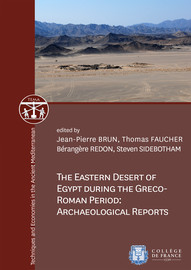ExtraitThe Eastern Desert of Egypt extends over a vast area of mountains and sandy plains between the Nile and the Red Sea. Its natural riches –gold, gems and high quality stones (such as granite from Mons Claudianus, Tiberianè or Ophiatès, porphyry from Porphyritès, basanites [greywacke] from the Wâdi al-Hammâmât, etc.)– have, despite the difficulties due to harsh climatic conditions, been exploited since the Predynastic period. The Pharaohs, the Ptolemies and the Roman emperors often sent exped...
Lire la suiteNote de l’éditeur
This book comes from a colloquium held at the Collège de France in Paris on March 30th and 31st, 2016.
Its objective was to take stock of the archaeological work of the last forty years by bringing together all the invited field actors to present a synthesis of their research on the occupation and exploitation of the Ptolemaic desert at the end of the Byzantine period.
Caption cover image: The Roman fort of Dios, 2nd-3rd century AD
© J.-P. Brun
Monday, September 17, 2018
The Eastern Desert of Egypt during the Greco-Roman Period: Archaeological Reports
The Eastern Desert of Egypt during the Greco-Roman Period: Archaeological Reports
Subscribe to:
Post Comments (Atom)










 Stumble It!
Stumble It!

No comments:
Post a Comment